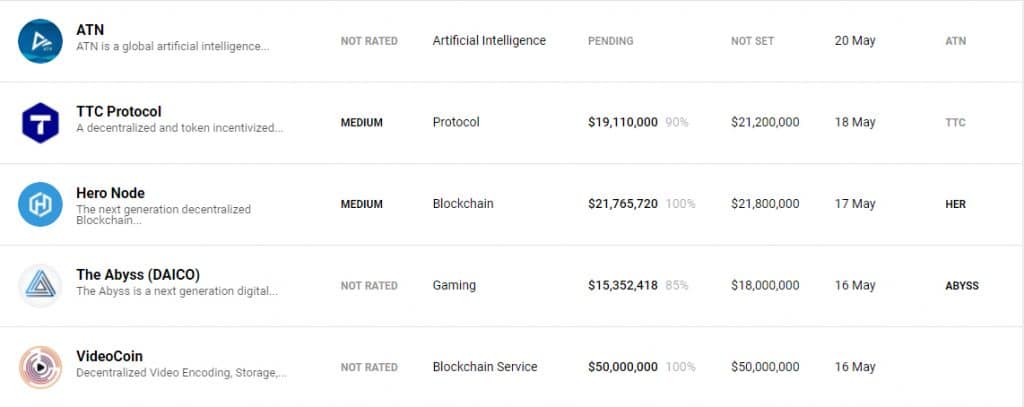By the end of Q2 in 2018, blockchain will still be soaring in popularity despite the recent plunge of Bitcoin and other mainstream cryptocurrency. There are increasing numbers of new blockchain projects launching, varying from gaming to artificial intelligence.
There are five projects worth mentioning. They are ATN, TTC Protocol, Hero Node, The Abyss and VideoCoin.
ATN, a global artificial intelligence project, has not set a ICO goal, while The Abyss, a gaming project, and TTC Protocol achieved 85% and 90% of their ICO goals, respectively. HeroNode and VideoCoin are the only two projects to get 100% to their ICO goal. Three of them are not rated, whereas HeroNode and TTC Protocol are rated as Medium Interest.
Among those projects that started a month ago, HER is worth highlighting. HER token was issued by Hero Node, a next generation decentralized Blockchain fog computing platform. At press time, the HER token price is $0.0226232 (+0.24%), equal to 0.0000428901 ETH or 0.00000333 BTC. Its 24-hur volume is $55,177 with a market cap of $9,153,646.
IcoDrops reported that HeroNode has generated $21,765,720 of its goal $21,800,000 (100%) during the ICO.
What is Hero Node? A new approach to DApp development…
Hero Node is a cross-blockchain, cross-platform development solution for DApp. It is based on the hero protocol and its vision is to integrate different public blockchains, somewhat akin to the Alibaba Cloud in the blockchain industry.
Hero Node introduces a new generation of decentralized computing based on what we call “fog computing,” and the HER token paves the way for developers to build on top of this platform. By building a cross-chain and cross-platform solution, Hero Node empowers developers to build DApps without needing to be experts in smart contracts.
Guoping Liu, the CEO and founder of Hero Node, summarized this opportunity and gaping hole in the market, saying, “The blockchain company who solves the tricky task of DApp development will dominate this next decade.”
How does this actually work on HeroNode? Developers can build a DApp based on Qtum, Ethereum IPFS or other DApps linked to public chains and they can be run on iOS, Android and HTML5. Developers can use this interoperability to build DApps without needing to delve deep into the highly-specialized architecture of blockchain development.
A Technical Guide to HeroNode
Hero Node’s development framework and underlying blockchain technology allows developers to pack applications into hash addresses and ensure the immutability of transactions. There are a few core elements at play:
• Public chain service: The Hero protocol integrates various public chains (ETH, QTUM, EOS) into a consistent API interface, allowing developers on Hero Node to develop their new business DApps without any understanding of these underlying blockchains.
- Storage service: Hero Node aims to create a node ecosystem on IPFS. In this ecosystem, data is generated by development, and applications are broken down and stored in various places on the Internet. This model for decentralized storage is like a drop of water poured into the sea: as long as the Internet exists, that data cannot be lost. Once a user wants to extract their data, Hero Node selects the nearest node to process that data and then promptly returns it to that user.
- Decentralization: Most blockchain applications still use domain names, calling into question how ‘decentralized’ they really are. Hero Node will help developers create their applications on distributed networks and run these applications by applying torrents. When an application becomes a torrent, neither the data nor the public chain are revocable, which allows the application to exist on the network forever. It is completely different from this arguably centralized, existing software (mode) life cycle (even for existing DApps).•Cross-platform application development tools: Blockchain applications will eventually come to grips with ordinary users who have no exposure to the technology and ecosystem. The experience must be seamless, and it will require blockchain applications to be installed and used on a user’s mobile phone, just like other existing common applications on iOS and Android. With its modular tools, Hero Node facilitates this seamless experience. By making the actual development process more streamlined across platforms, both developers and end users can experience decentralized applications without the clunky and siloed interface of existing platforms.This is a paid post provided by U.S. Blockchain.








